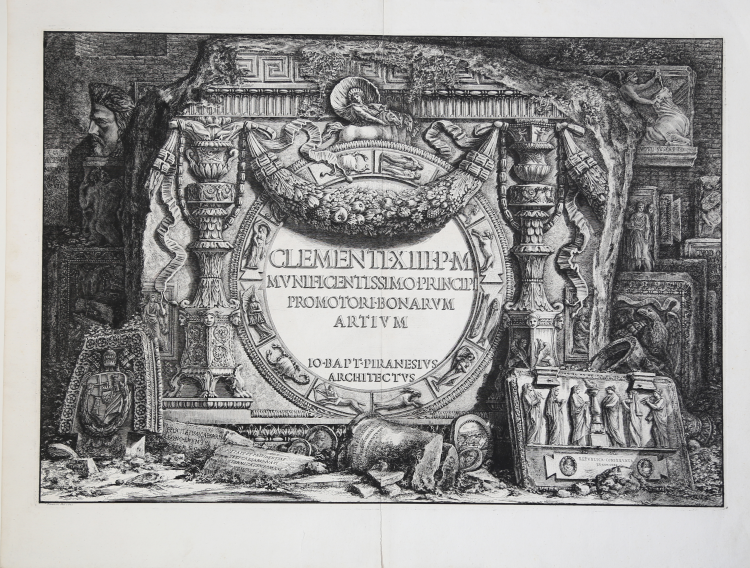




| Reference: | S7826 |
| Author | Giovan Battista PIRANESI |
| Year: | 1761 |
| Printed: | Rome |
| Measures: | 660 x 460 mm |



| Reference: | S7826 |
| Author | Giovan Battista PIRANESI |
| Year: | 1761 |
| Printed: | Rome |
| Measures: | 660 x 460 mm |
Etching, 1764, signed on plate at lower left: Piranesi inv e inc.
Among the fragments of architectural decoration, a marble slab richly carved and englanded has in the center a medallion with around the signs of the zodiac and in the middle the dedication in relief: CLEMENTIS XIII PM/ MUNIFICENTISSIMO PRINCIPI/ PROMOTORI BONARUM/ ARTIUM /IO BAPT PIRANESIUS/ ARCHITECTUS
Double-page dedication to Pope Clement XIII, from the work Le Antichità di Albano e di Castel Gandolfo
Piranesi's archaeological studies in the area of Lake Albano, initiated by his work on the Emissario , were greatly encouraged by Pope Clement XIII whose summer residence at Castel Gandolfo overlooked the lake . At the suggestion of this major patron, who helped to defray the considerable costs, the artist produced a particularly handsome treatise devoted to the local antiquities and dedicated to the Pope. In this work, which is often bound with the works on the Emissario and the Due Spelonche , Piranesi extended his illustrative techniques of combining emotive vedute with highly technical , and often speculative , diagrams on aspects of Roman construction.
Magnificent example, printed on contemporary laid paper, in excellent condition.
|
Wilton-Ely, 639; Focillon 506; Petrucci, n. 457
|
Giovan Battista PIRANESI (Mogliano Veneto 1720 - Roma 1778)
|
Italian etcher, engraver, designer, architect, archaeologist and theorist. He is considered one of the supreme exponents of topographical engraving, but his lifelong preoccupation with architecture was fundamental to his art. Although few of his architectural designs were executed, he had a seminal influence on European Neo-classicism through personal contacts with architects, patrons and visiting artists in Rome over the course of nearly four decades. His prolific output of etched plates, which combined remarkable flights of imagination with a strongly practical understanding of ancient Roman technology, fostered a new and lasting perception of antiquity. He was also a designer of festival structures and stage sets, interior decoration and furniture, as well as a restorer of antiquities. The interaction of this rare combination of activities led him to highly original concepts of design, which were advocated in a body of influential theoretical writings. The ultimate legacy of his unique vision of Roman civilization was an imaginative interpretation and re-creation of the past, which inspired writers and poets as much as artists and designers.
|
|
Wilton-Ely, 639; Focillon 506; Petrucci, n. 457
|
Giovan Battista PIRANESI (Mogliano Veneto 1720 - Roma 1778)
|
Italian etcher, engraver, designer, architect, archaeologist and theorist. He is considered one of the supreme exponents of topographical engraving, but his lifelong preoccupation with architecture was fundamental to his art. Although few of his architectural designs were executed, he had a seminal influence on European Neo-classicism through personal contacts with architects, patrons and visiting artists in Rome over the course of nearly four decades. His prolific output of etched plates, which combined remarkable flights of imagination with a strongly practical understanding of ancient Roman technology, fostered a new and lasting perception of antiquity. He was also a designer of festival structures and stage sets, interior decoration and furniture, as well as a restorer of antiquities. The interaction of this rare combination of activities led him to highly original concepts of design, which were advocated in a body of influential theoretical writings. The ultimate legacy of his unique vision of Roman civilization was an imaginative interpretation and re-creation of the past, which inspired writers and poets as much as artists and designers.
|